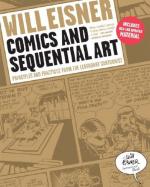
|
Chapter 1
• Chapter 1 develops a philosophical introduction for the history and evolution of sequential art in its modern form.
• Around 1934, daily comic strips began making their first appearance. These comics strips are now the mainstream medium for sequential art.
• Chapter 1 stresses that reading comics involves reading more than just words. Pictures, maps, and images must be read as well.
• To be able to read comics, the reader must utilize skills of both visual and verbal interpretation.
• Eisner compares comics to language and explains how the repetitiveness of comics functions as symbols in language, thereby creating its own grammar.
• Eisner analyzes one of his Spirit stories in which the hero wishes he could fly but is hit by a bullet. This bullet causes the hero to fly through the air and strike the earth. Eisner breaks the left-to-right convention by having the hero's body break through the right-hand margin down...
|
This section contains 2,081 words (approx. 7 pages at 300 words per page) |

|




